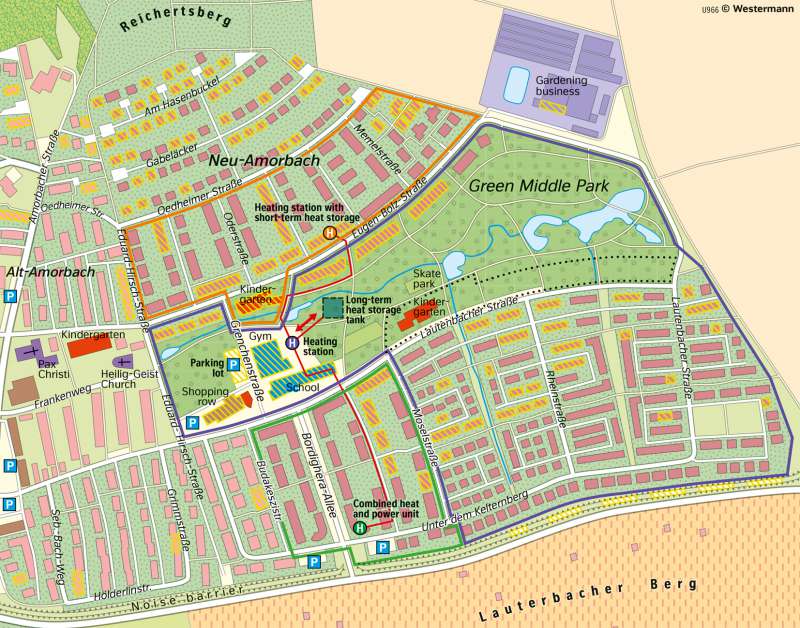Neckarsulm-Amorbach - Solar-assisted heating in a residential district
Sustainable development
978-3-14-100890-6 | Page 96 | Ill. 3

Overview
Neckarsulm is located in a region that receives between 1050 and 1100 kWh/m² of global radiation. It is therefore well suited for the use of solar energy. The construction of suitable house and roof areas is also easier in a newly planned district than in existing buildings.
Large solar installations are located on the low-energy houses between Oedheimer Straße and Eugen-Bolz-Straße, on the central kindergarten, the sports hall and the school, on the covered car park and the shopping centre, and on the noise barrier south of Amorbach.
On the one hand, the solar energy is used to generate electricity (photovoltaics), on the other hand to heat up water (solar thermal). The hot water is pumped in a long-term storage system deep in the ground, where it heats up the sedimentary rocks. This ground storage is able to conserve heat for weeks, until additional heat energy is needed in the houses above.
Neckarsulm-Amorbach solar district
More than 20 years ago, a new district was planned in the East of Neckarsulm-Amorbach, in which solar thermal energy and local heating supply were to play a special role. The concept with three so-called ‘local heating islands’ and an underground heat storage system was promoted by the German Ministry of Research and the Ministry of the Environment and accompanied scientifically. One of the targets was that the energy costs for the residents should not be much higher than with a natural gas supply.
The solar collectors installed on many roofs generate large amounts of hot water, which is stored in short-term storage tanks and piped from there to the houses. If the irradiation is not sufficient, the water is reheated. One of the heating centres also houses a combined heat and power plant.
An underground long-term heat storage system under the green area is used to store the energy from times with a lot of solar radiation for phases with poorer weather. In this way, solar heat from the summer can also be used in winter. The long-term storage tank is therefore connected to the three heating centres by heat pipes. Below ground level, the heat exchanger is made up of many interconnected boreholes, that heat the surrounding rock.
Experiences with the long-term storage tank
An underground long-term storage system of this size is not a matter of course, even in solar housing estates, and has not been realised in this way very often to date. In the concept of solar local heating supply, the underground heat storage system is not an indispensable component - but it makes this concept more independent of the weather and thus more efficient.
The technical experience with underground heat storage has not been entirely positive; there have also been setbacks and malfunctions. Overall, however, it was possible to demonstrate, what the graphic also expresses: With underground heat storage, it is possible to carry over the surplus of solar-generated heat in the summer into the winter half-year. This creates an ecologically and economically sustainable circulation system.
Local heating districts
The two smaller "local heating islands" Eugen-Bolz-Straße and Bordighera-Allee were already built in the 1990s with multi-storey low-energy houses. In a low-energy house, the thermal insulation of the outer walls and the roof is so efficient, that significantly less energy is needed for heating (than is specified as the upper limit in the legal requirements). The water used for heat transport and storage is predominantly heated with solar energy generated on the rooftops
The largest local heating island, Grenchenstraße, has only been completed in the last few years. First, a district centre was built with several public facilities and surrounding multi-storey residential buildings. More than ever, attention was paid to planning large collector surfaces on the roofs. To the East, apartment buildings and single-family houses are attached, which contribute further solar collector area. While the development was still underway, there were not enough customers for the local heat. Only soon can it be assessed whether this supply system will pay off in the long term.
However, it is also interesting to see the impact of the increased construction of solar roofs in the surrounding area: There are also a lot of solar installations in the neighbouring single-family housing estates. On the one hand, this indicates the good natural conditions for solar thermal energy and photovoltaics, but on the other hand it also speaks for a certain propagation effect of this energy use concept.




